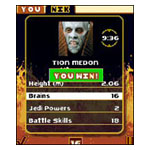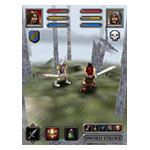Top 10 mobile gaming trends in 2007 (part 2)
More analysis of what went right and wrong this year

We've covered the first five industry trends from 2007 already (they were Waiting for N-Gage; Brands subsidising original games; The early days of ad-funded games; The New Hardcore; and Market consolidation, but you can read the full piece here).
So, onto the five final trends we've identified this year.
Web/mobile casual convergence
.jpg) This is another trend still in its early stages, but there were definite signs this year that the worlds of mobile and casual web gaming are coming together. Witness online firm PopCap Games self-publishing its first two mobile games: Chuzzle (pictured) and Bookworm.
This is another trend still in its early stages, but there were definite signs this year that the worlds of mobile and casual web gaming are coming together. Witness online firm PopCap Games self-publishing its first two mobile games: Chuzzle (pictured) and Bookworm.
Check mobile publisher I-play getting bought by online gaming firm Oberon Media. And see the first mobile games companies turning their games into Facebook applications – Tower Bloxx and Playman Summer Games 2 are already on there, with more to come in 2008.
And, of course, there's been a continued stream of casual games from the web to mobile, from match-three puzzlers through to Diner Dash-style working games. With similarities between the demographics of web and mobile gamers, and several companies now with a foot in both camps, expect this convergence to continue in 2008.
Connected mobile games still thin on the ground
 We still remember the rash of industry conferences about '3D and Multiplayer Mobile Games' two to three years ago, where those two areas were expected to be the next big things in mobile entertainment. Since then, people have realised that perhaps multiplayer mobile gaming isn't such a big deal, given the short play sessions that characterise the platform.
We still remember the rash of industry conferences about '3D and Multiplayer Mobile Games' two to three years ago, where those two areas were expected to be the next big things in mobile entertainment. Since then, people have realised that perhaps multiplayer mobile gaming isn't such a big deal, given the short play sessions that characterise the platform.
However, even the more appealing idea of connected games – high-score tables, communities and so on – have been relatively slow to take off. It's been a case of piecemeal developments, rather than the Xbox Live-style communities we were hoping for.
So, on the operator side, 3 has been selling multiplayer games for a while now, but they're not super high-profile. T-Mobile launched its own suite of multiplayer games, including Worms and Top Trumps (pictured). And individual publishers released titles with connected aspects, such as the high-score tables found in Glu's Project Gotham Racing or several Disney games.
We're still waiting for connectivity to really take off in an organised way on mobile, though. Maybe next year.
3D has quietly become part of the furnishing
 Getting back to those 'Multiplayer/3D' industry events, 3D was definitely being hyped as the crucial element to make mobile gaming grow, with much talk of PlayStation-quality graphics and phones rivalling DS and PSP for processing power soon, and the wonderful gaming goodness that would ensue.
Getting back to those 'Multiplayer/3D' industry events, 3D was definitely being hyped as the crucial element to make mobile gaming grow, with much talk of PlayStation-quality graphics and phones rivalling DS and PSP for processing power soon, and the wonderful gaming goodness that would ensue.
You know what? It has happened, but the hype has thankfully died away (as have the rash of games with '3D' in the title). So 3D is just now part of many top games, without publishers making a big deal out of it. If you have a decent handset, you get the 3D version, and if you don't, you don't.
But 3D is there to great effect on some genres where it makes sense: racing games, football titles, even RPGs like Blades & Magic (pictured). It's not a gimmick in most cases, it's just there. And the quality is as good as the original PlayStation, and beyond.
Games are better, and phones are better for playing them
 This is one of those issues that often gets forgotten amid the worrying about whether the mobile game industry is growing as fast as it could be. But the fact is, the majority of widely available games are much better now than they were a few years ago.
This is one of those issues that often gets forgotten amid the worrying about whether the mobile game industry is growing as fast as it could be. But the fact is, the majority of widely available games are much better now than they were a few years ago.
They look better. They play better. They even sound better. Well, some of them do. If you were to play two games from the same genre, with one released in 2004 and one released in 2007, you'd notice a huge difference. There are still some stinkers, of course – we make sure we don't pull our punches when we review them – but 2007 has seen the quality of mobile games continue to increase across the board.
What's more, phones are better for playing games, too. We should particularly credit Sony Ericsson, which has released a stream of handsets that are great for gaming. Nokia, too, has turned out some good gaming handsets, give or take the odd keypad quirks (if we accidentally hit the red call-end button and quit out of a game on our N73 again, it's going through the window).
But, yes, mobile gaming in 2007 is a much more pleasurable experience than it was even a couple of years ago. We should celebrate that fact.
Cool developer start-ups springing up
It's a fact that in any industry, small companies get bought by bigger companies, and some people end up a year or two later deciding that, actually, they preferred working at a small company. So they leave and start one.
We've seen that happen towards the end of 2007. For example, InfoSpace Mobile's well-regarded UK games team split off and set up a new developer called FinBlade, which is already working on some innovative games.
A group of former Glu Mobile people, meanwhile, has formed Playfish, which as we reported last week has launched its first Facebook game, and is aiming to explore new forms of social gaming. Around the world, similar start-ups are appearing with the determination to make it as independent developers. The results should be interesting.
That's it for our second and final part of our ten key mobile gaming trends of the year. Catch you again in 12 months' time when we'll look back at 2008.
